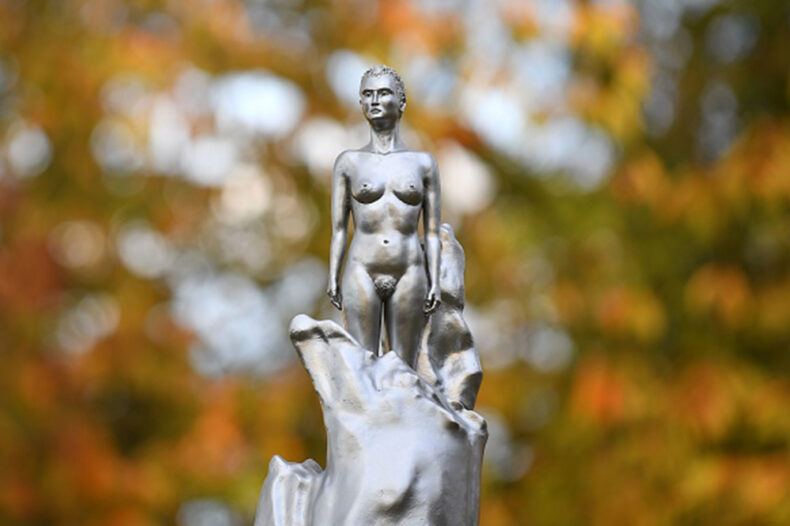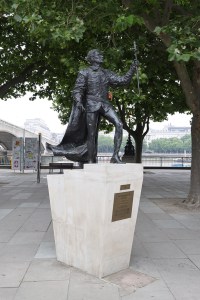Art UK’s newly-launched catalogue of British public sculpture is an extraordinary achievement. It features more than 13,500 works, ranging from realistic statues of politicians, writers and other people of note to abstract sculptures, as well as war memorials, mosaics, murals, busts, plaques and other types of monuments or public art. (The cataloguing of sculptures in public collections will be finished later in the year.) Where the details are known, it includes the creator(s), medium, year of construction or installation, acquisition method and notes about its form and content. By doing so, it reminds us how the sculptures, which for many people fade into their townscapes, came to be and what they represent.
Statues have recently been the focus of much media attention, be they of colonialists in the UK, Confederate generals in the United States or Communist leaders in Ukraine. The controversy over the statue of Edward Colston in Bristol, for example, was about content: many people did not want an endorsement of a slave trader who was linked to nearly 20,000 deaths in their city and, after years of campaigning for its removal were ignored, took the matter into their own hands. The style of the monument, a realistic depiction made of bronze by Irish sculptor John Cassidy in 1895, was not the issue. More often, however, public sculpture attracts opprobrium when it experiments with form, echoing long-standing arguments about the nature of architecture: see Maggi Hambling’s conceptual homages to Oscar Wilde and, more recently, Mary Wollstonecraft.

The sculpture for Mary Wollstonecraft by Maggi Hambling on Newington Green in north London. Photo: Justin Tallis/AFP via Getty Images

Laurence Olivier (1907–1989) (2007), Angela Conner. Photo: Vincenzo Albano/Art UK
The decision to catalogue figurative sculptures as well as more experimental monuments and purely abstract works of public art leaves it to the viewer to question the relationship between statues, monuments and artworks. Searching Art UK’s database, I was intrigued to learn that two of the pieces most familiar to me are by Angela Conner (b. 1935), a sculptor who apprenticed with Barbara Hepworth. The first is her realistic statue of Laurence Olivier as Hamlet, installed in 2007 outside the National Theatre on the Southbank in London, where I often spend an evening. The second is her more conceptual Cosmic Cycle (The Rising Universe) in central Horsham, a deeply conservative town in West Sussex, where I went to college in the late Nineties.
Conner’s sculpture – commissioned to mark the bicentenary of the birth of Percy Bysshe Shelley in nearby Warnham – was never known by its official title, but instead as ‘Shelley Fountain’ or, less politely, as ‘The Bollock’. The large kinetic piece, consisting of a globe that filled with water as it rose and fell, was treated with little respect by youngsters – who skateboarded on it and poured washing-up liquid into the basin to watch the water bubble over – or by the town council. In April 2016, Horsham District Council voted overwhelming to dismantle Cosmic Cycle, which, it said, had cost more than £200,000 to maintain and repair during its 20-year existence. Conner told the BBC that ‘concerted effort has been made to slowly have the sculpture literally disintegrate’ and that ‘I can’t believe the lack of care that’s taken place.’ A councillor dealing with culture said the council could no longer sustain the water feature, which, he felt, was ‘unfair to the art’, and it was removed. With Shelley’s grave being in the Protestant cemetery in Rome (and his heart buried in Dorset), there is currently no monument to one of England’s greatest poets near his birthplace, although the Shelley Memorial Project were hoping to raise £40,000 to install one .
Art UK’s database records Cosmic Cycle as lost, which isn’t quite true. It was sold and moved to Westenhanger Castle in Kent, with the promise that it would be fully refurbished. I don’t dislike the work, but it always seemed incongruous with its surroundings – and I question the wisdom of building a fountain for someone who died at sea. These doubts are, of course, about form: there was never any controversy about the idea of a monument to Shelley per se, even though his radical politics are at odds with the area’s long Tory history. A more straightforward statue would likely have met a warmer reception.
But such a monument would, I think, do Shelley a disservice. Conner was inspired by his poem ‘Mont Blanc’, rather than his better-known ‘Ozymandias. The latter, which was prompted in part by the gigantic statue of Ramses II that Giovanni Belzoni bought for the British Museum in 1817, can be read as a commentary on the bathos of all monuments. A sculpture responding in turn to ‘Ozymandias’ might demonstrate a fascinating relationship between form and content and the aesthetic and ideological nature of such public commemoration. It might not be universally adored – but is any piece, especially on its inauguration? And how would we arrive at works that genuinely enrich our public space without artists – be they Conner, Hambling or anyone else – being allowed to take risks?

We now know where all the UK’s public sculptures are – but are they any good?
Cosmic Cycle (Rising Universe) in the centre of Horsham, West Sussex, commissioned to mark the bicentenary of the birth of Percy Bysshe Shelley and removed in 2016. Photo: Alamy Stock Photo
Share
Art UK’s newly-launched catalogue of British public sculpture is an extraordinary achievement. It features more than 13,500 works, ranging from realistic statues of politicians, writers and other people of note to abstract sculptures, as well as war memorials, mosaics, murals, busts, plaques and other types of monuments or public art. (The cataloguing of sculptures in public collections will be finished later in the year.) Where the details are known, it includes the creator(s), medium, year of construction or installation, acquisition method and notes about its form and content. By doing so, it reminds us how the sculptures, which for many people fade into their townscapes, came to be and what they represent.
Statues have recently been the focus of much media attention, be they of colonialists in the UK, Confederate generals in the United States or Communist leaders in Ukraine. The controversy over the statue of Edward Colston in Bristol, for example, was about content: many people did not want an endorsement of a slave trader who was linked to nearly 20,000 deaths in their city and, after years of campaigning for its removal were ignored, took the matter into their own hands. The style of the monument, a realistic depiction made of bronze by Irish sculptor John Cassidy in 1895, was not the issue. More often, however, public sculpture attracts opprobrium when it experiments with form, echoing long-standing arguments about the nature of architecture: see Maggi Hambling’s conceptual homages to Oscar Wilde and, more recently, Mary Wollstonecraft.
The sculpture for Mary Wollstonecraft by Maggi Hambling on Newington Green in north London. Photo: Justin Tallis/AFP via Getty Images
Laurence Olivier (1907–1989) (2007), Angela Conner. Photo: Vincenzo Albano/Art UK
The decision to catalogue figurative sculptures as well as more experimental monuments and purely abstract works of public art leaves it to the viewer to question the relationship between statues, monuments and artworks. Searching Art UK’s database, I was intrigued to learn that two of the pieces most familiar to me are by Angela Conner (b. 1935), a sculptor who apprenticed with Barbara Hepworth. The first is her realistic statue of Laurence Olivier as Hamlet, installed in 2007 outside the National Theatre on the Southbank in London, where I often spend an evening. The second is her more conceptual Cosmic Cycle (The Rising Universe) in central Horsham, a deeply conservative town in West Sussex, where I went to college in the late Nineties.
Conner’s sculpture – commissioned to mark the bicentenary of the birth of Percy Bysshe Shelley in nearby Warnham – was never known by its official title, but instead as ‘Shelley Fountain’ or, less politely, as ‘The Bollock’. The large kinetic piece, consisting of a globe that filled with water as it rose and fell, was treated with little respect by youngsters – who skateboarded on it and poured washing-up liquid into the basin to watch the water bubble over – or by the town council. In April 2016, Horsham District Council voted overwhelming to dismantle Cosmic Cycle, which, it said, had cost more than £200,000 to maintain and repair during its 20-year existence. Conner told the BBC that ‘concerted effort has been made to slowly have the sculpture literally disintegrate’ and that ‘I can’t believe the lack of care that’s taken place.’ A councillor dealing with culture said the council could no longer sustain the water feature, which, he felt, was ‘unfair to the art’, and it was removed. With Shelley’s grave being in the Protestant cemetery in Rome (and his heart buried in Dorset), there is currently no monument to one of England’s greatest poets near his birthplace, although the Shelley Memorial Project were hoping to raise £40,000 to install one .
Art UK’s database records Cosmic Cycle as lost, which isn’t quite true. It was sold and moved to Westenhanger Castle in Kent, with the promise that it would be fully refurbished. I don’t dislike the work, but it always seemed incongruous with its surroundings – and I question the wisdom of building a fountain for someone who died at sea. These doubts are, of course, about form: there was never any controversy about the idea of a monument to Shelley per se, even though his radical politics are at odds with the area’s long Tory history. A more straightforward statue would likely have met a warmer reception.
But such a monument would, I think, do Shelley a disservice. Conner was inspired by his poem ‘Mont Blanc’, rather than his better-known ‘Ozymandias. The latter, which was prompted in part by the gigantic statue of Ramses II that Giovanni Belzoni bought for the British Museum in 1817, can be read as a commentary on the bathos of all monuments. A sculpture responding in turn to ‘Ozymandias’ might demonstrate a fascinating relationship between form and content and the aesthetic and ideological nature of such public commemoration. It might not be universally adored – but is any piece, especially on its inauguration? And how would we arrive at works that genuinely enrich our public space without artists – be they Conner, Hambling or anyone else – being allowed to take risks?
Share
Recommended for you
Monumental folly – what Colston’s statue says about Victorian Bristol
The statue of the 18th-century slave trader is the result of a 19th-century attempt to sanitise the past
Diana was a fashion icon, so why is her statue in Kensington Gardens so badly dressed?
The disappointing bronze figure raises the difficult question of what a well-dressed statue should wear these days
‘The thing is to be brave’ – Maggi Hambling toughs it out
From that scandalous scallop to her Mary Wollstonecraft monument, Maggi Hambling is no stranger to controversy